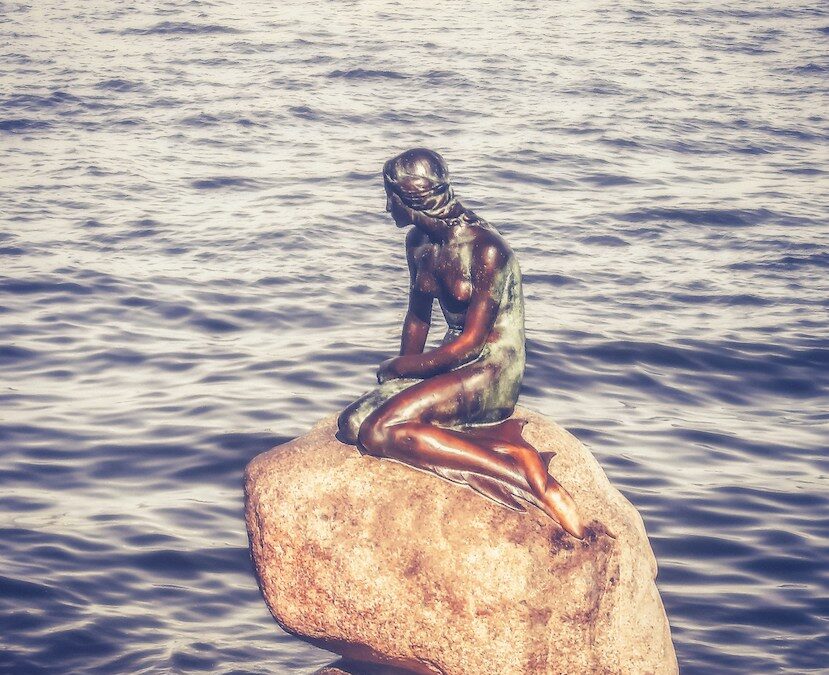“… and she put a wreath of white lilies round her hair, but every petal of the flowers was half a pearl.”
~ Hans Christian Andersen, The Little Mermaid
Dear fellow fairytale lovers & readers,
This is part of my series “The Story Threads”where I discuss the esoteric symbology and layers of wisdom found in famous tales, lore and myth, and how it all relates to our current times and the evolution of our consciousness. Previous posts in these series include What Donkeyskin Knows, What Cinderella Knows, What The Snow Queen Knows, What Sleeping Beauty Knows, What Rapunzel Knows, Wild Marriage, The Gift of the Magi, The Dandelion Girl, What Snow White Knows, Beauty and Her Beast, Weaving Life, Bluebeard, Étaín, Little Red Riding Hood, and many more that you can find in my folklore + myth section.
Today we’ll travel to Denmark to dive into the deep blue seas where a beautiful girl once lived, whose voice was taken away. So I want to give her back her voice, and celebrate her for her true story as many people seem to not really know it. While it is interesting and natural for people to retell and remake old stories, it is just as important to remember the old original stories. True inclusivity relies upon giving honour and respect to the original stories, creators and characters, and valuing the diversity of various cultures, lore and heritage.
Let’s begin.

Art by John William Waterhouse
Mermaids in lore and myth
Since the time of early mythology, fantastical creatures of the sea have had a place in the oral traditions of folklore, and merfolk exist in stories from all over the world, and are represented in a multitude of forms. Mermaids in particular date back to around 1000 BC in Assyria, and have been interpreted through lore, myth and tales throughout the world.
In folklore tradition, the mermaid is often seen as a symbol of freedom, as she has all the wide sea for her home, and she is also considered a symbol of sensuality. Water is her element, and all the wonders of the undersea world are her birthright.
In many tales and cultural beliefs, mermaids were actually seen as dangerous because they had the ability to seduce men and take them into the depths of seas. Many fishermen would even be wary of the siren’s calls, and not stay for too long and too far into the seas.

The Little Mermaid illustrated by Galia Zinko
Mermaid stories are usually classified as part of the Animal Bride tradition. The Animal Bride and Bridegroom represent the wild within each one of us, and you can read my essay on Wild Marriage to explore the various mystical landscapes where two worlds meet and kiss. These stories also represent the wild within our lovers and spouses, the parts of them that we’ll never fully know no matter how long we’ve lived together under the same roof. They represent the others who live unfathomable and mysterious lives right beside us — cat and mouse and fox and rabbit; the others that live only in the dreams or nightmares of our imaginations; the others that live unknowingly within us, wisely hidden in the corners of our psyche.
For thousands of years, animal bride and bridegroom tales have emerged from the places where two different worlds cross paths to meet with the intention to deepen into understanding and perhaps even reconcile our differences settling into greater harmony and peace; as we too reconcile the worlds between wildlife and human beings, the natural and the man-made, nature and civilization, the abstract and the concrete, the soft and the stable, magic and illusion.
Hans Christian Andersen and the Little Mermaid
Danish writer Hans Christian Andersen (1805-1875) was quite knowledgeable on mermaids as they frequently appeared in popular culture during the period in which he lived. For example, the original ballad Agnete and the Merman or in Danish Agnete og Havmanden, is one of the many fairy tales found in Danish folklore. The poem was passed on by word of mouth for generations, like numerous other folktales, and mermaids were very important in traditional Danish lore. While the origins of Agnete may go back to before the 13th century, it was set down in writing much later on, in the 16th century.
Andersen loved mermaids and earlier in his life he wrote both The Little Sea Maid and Agnete and Merman, the latter of which he also reworked as a play that was staged with music in 1834.

The Little Mermaid illustrated by Galia Zinko
Andersen used various elements of traditional mermaid lore and characteristics, while creating his own very personal and unique version that is original in its story.
His Little Mermaid tale was first published in 1837 as part of a collection of fairy tales for children, though he intended for it to be read mainly by adults not children.
Unlike the Disney version, Andersen’s tale is a tragic story in which the mermaid trades her tail for legs “as sharp as knives,” all for a prince who is unable to love her back. He marries another, and the mermaid is reduced to foam upon the sea.
Many Andersen scholars view this story as a reflection of its author’s own tendency to fall passionately in love with those who did not love him back.
But I think it goes a little further than that. Andersen grew up working class and was desperately poor; and even when, many years later, he eventually achieved fame and fortune, he was still unappreciated by the higher class of 19th century Copenhagen.
He lived among them, but he was never really one of them, which only perpetuated his feelings of not belonging and of being an outsider no matter what he did, no matter his talent, no matter his skills, no matter his hard work and hard earned fortune.
In a way, his voice wasn’t truly appreciated and recognized and honoured and respected in the way it should have been; and as the little mermaid too, he felt robbed of it. In his story, her voice is her purpose and who she truly is, as for a mermaid, her voice is what a heart to us as human beings.
This story reminds us that love can only happen if we are valued for who we really and truly are. We cannot sacrifice our true inner self, not should we, just to gain someone’s love or affection, or feel a sense of belonging or inclusivity.
Original illustrations
Danish painter and illustrator Vilhelm Pedersen was the first to illustrate the stories of Hans Christian Andersen. His works of the Little Mermaid show her gentleness and child-like innocence to represent the average Danish girl that Andersen had in mind when writing the tale.

The Little Mermaid illustrated by Vilhelm Pedersen
A few years later, British artist Maxwell Armfield illustrated in colour the collection of Andersen’s tales The Mermaid and Other Tales. The book was bound and decorated intricately with gold leaf, and featured beautiful illustrations with a wide range of shades and tones. Armfield was known for his extreme care in imagining life for merfolk; and we see The Mermaid’s long, flowing blonde hair masking her body partially, which added to the allure of the lore of mermaids. The clothing of the Prince, and the structure of the ships, were intricately illustrated as well, portraying the grandeur and exoticism of human life to which the mermaid was attracted.


The Little Mermaid illustrated by Maxwell Armfield
Armfield chose to do only illustrations for the Little Mermaid. In the first we see her seeing the ship for the first time; and in the second, she meets the prince after she has gained human legs.
In 1989 Disney adapted the tale to make it into animation and they gave Andersen’s mermaid a name: Ariel. The story was changed to be made into a more child friendly narrative with Ariel and the prince marrying happily at the end. Though Disney knew the earliest and original illustrations of the mermaid, according to their official statement the colour of Ariel’s hair was of much debate and “a point of contention among the team.” While many of the team wanted to keep her hair blonde, some thought that it would look too similar to Hannah’s character; and since red was a complementary colour to Ariel’s green tail, they made the choice for her fiery red long hair.

The Little Mermaid illustrated by Arthur Rackham
Aside from the original 19th century illustrations, we’ve had many other beautiful portrayals of the Little Mermaid, and one of my most favourite are the illustrations of Christian Birmingham, who never fails to capture the magical spirit of tales such as Sleeping Beauty, the Little Mermaid and the Snow Queen.
We also have other illustrations by famous artists such as Arthur Rackham, Edmund Dulac, and Helen Stratton, who gifted us with their beauty and talent. I am especially in love with Stratton’s work – and even though her drawings are in black and white, you can feel the mermaid’s gentleness and innocence, which are true to the soul and heart of the original story. And in this article I’ve also featured some more modern illustrations of the tale by Galia Zinko, whose colours are stunning.

The Little Mermaid illustrated by Christian Birmingham
The story
Andersen’s tale is a tragic one and I remember when I heard it the first time it was absolutely heart-breaking. I’ve contemplated about whether it is appropriate for children, and I feel more swayed to say that yes it is but for older kids. Children still go through their difficult and heart-breaking times, even if we think they don’t, their worlds are very fragile. And when they can’t make sense of all around them and of the extremity of the emotions that take them like waves, it is precisely tales that offer them comfort and support in understanding. It allows them to see their own emotions, anger, pains and hurt, and project them healthily onto the characters, so that they feel less alone in the times when they can’t or are not able to express how they feel. Having said all that though, many of Andersen’s tales are in my opinion more suited for older children because they are indeed very sad; but the beauty of his language and depth of meaning are surely to be shared.

The Little Mermaid illustration by Helen Stratton
In Andersen’s tale the mermaid goes through many sacrifices, and the moral is very realistic: not all will be rewarded. A great lesson for girls is that love can only be true if they are valued for who they really are, fish tail and all. Don’t sacrifice your inner essence, your true self, your voice, and all that matters deeply to you, for the sake of love. Love wouldn’t ask you to do that anyway. Love is the acceptance of who we are, and there is no need to sacrifice parts of yourself for someone to love you.
Another gentle warning by Andersen was that we shouldn’t fall prematurely into actions aroused by strong desires only. In many ways, and like many other tales, this story too is a coming of age story, also known as bildungsroman. A bildungsroman is a literary genre that focuses on the psychological and moral growth of the protagonist from childhood to adulthood; and so the change or transformation of the character is at the heart of the story. The mermaid’s initiation begins at the age of fifteen, and then throughout the story she faces many personal and physical challenges that eventually cause her to become more mature and adult-like.
At the beginning of the tale she is very child-like, though since a young age she dreams of the human world and with great excitement waits for other mermaids to come back from the surface and tell her stories of all they saw.
At fifteen years old, she is finally allowed to swim to the surface of the sea herself and see the beauty of nature, flowers, ships, and scents for which she’s always longed for and dreamt.
Once the mermaid experienced life above the sea seeing the prince, she began to experience a sense of love and lust towards him; and the yearnings and longings of her heart gave her no rest. At first, she hid from him and becomes timid, watching him from a distance, which portrays her child-like reaction to her new powerful and undeniable feelings.
“But a mermaid has no tears, and therefore she suffers so much more.”
When a storm breaks out on the ship and she sees the prince drowning, she swims towards him, holds him in her arms through the storming waves, and brings him to shore where he’s now safe.
“Now he is certainly sailing above, he on whom my wishes hang, and in whose hand I should like to lay my life’s happiness. I will dare everything to win him and an immortal soul.”
The Little Mermaid becomes melancholic and asks her grandmother if humans can live forever. The grandmother explains that humans have a much shorter lifespan than mermaids who naturally live 300 years, but humans have an eternal soul that lives on in heaven, while mermaid turn to sea foam at death and cease to exist.
“We have no immortal souls,” said the grandmother, “we have no future life; we are just like the green sea-weed, which, once cut down, can never revive again! Men, on the other hand, have a soul which lives for ever, lives after the body has become dust; it rises through the clear air, up to the shining stars!”

The Little Mermaid illustration by Helen Stratton
Longing for an eternal soul and the love of the prince, The Little Mermaid decides to visit the sea witch who lives in a dangerous part of the ocean to ask her for help to become human.
“I know what you want. It is very stupid of you, but you shall have your way, just know that it will bring you to sorrow, my pretty princess,” said the sea witch.”
The witch agrees to help her by selling her a potion that will give her legs but only in exchange for her voice, as the Little Mermaid had the most enchanting and beautiful voice in the entire world; but she warns her that once she becomes a human, she will never be able to return to the sea and that consuming the potion will make her feel as if a sword is being passed through her body.
The witch tells her that once she recovers from the potion, she will have two human legs and will be able to dance like no human has ever danced before; however, she will constantly feel as if she is walking on sharp knives. Moreover, she will obtain a soul only if she wins the love of the prince and marries him, for then a part of his soul will flow into her. Otherwise, at dawn on the first day after he marries someone else, the Little Mermaid will die with a broken heart and dissolve into sea foam upon the waves.
“Then your tail will divide and shrink until it becomes what the people on earth call a pair of shapely legs. But it will hurt; it will feel as if a sharp sword slashed through you. Everyone who sees you will say that you are the most graceful human being they have ever laid eyes on, for you will keep your gliding movement and no dancer will be able to tread as lightly as you. But every step you take will feel as if you were treading upon knife blades so sharp that blood must flow. I am willing to help you, but are you willing to suffer all this?”
“Yes,” the little mermaid said in a trembling voice, as she thought of the Prince and of gaining a human soul.”

The Little Mermaid illustrated by Christian Birmingham
When the mermaid goes to bargain with the sea witch we see the portrayal of her now adolescent phase of maturation. By not carefully considering the consequences of the deal, and we’ve all been teenagers so we know how we don’t really think things through, the mermaid agrees to sacrifice her voice and walk on knives in constant pain. She sacrifices the one thing that is her true self – and is her very purpose of being who she is: a mermaid.
After she agrees to the arrangement, the Little Mermaid swims up to the surface near the prince’s castle and drinks the potion. The liquid feels like a sword piercing her body and she passes out on the shore, naked. She is found by the prince, who is mesmerized by her beauty and grace, even though he discovers that she is mute.
“Never had she danced so beautifully; the sharp knives cut her feet, but she did not feel it, for the pain in her heart was far greater.”
They spend many days together thereafter, and he loves to see her dance, and she dances for him constantly despite suffering excruciating pain with every step. Soon, the Little Mermaid becomes the prince’s favorite companion and accompanies him on many of his outings, but unfortunately he does not fall in love with her at all.


The Little Mermaid illustrated by Christian Birmingham
He said that he made a vow to marry only the one who saved him that day from the storm, and without her voice, the Little Mermaid wasn’t able to tell him the truth, and even express what she felt towards him. Eventually he marries another woman thinking mistakenly that she was the one who saved him. On the wedding night the mermaid knows she’ll die at dawn, but her sisters come to the surface to offer her help. They’ve sold their hairs to the sea witch, so that she gives them a magical knife with which if the Little Mermaid chooses to kill the prince, she’ll gain back her tail and come back home to them. However, she can’t do that … she loves him.
At dawn, she becomes foam, but instead of ceasing to exist, she feels the warm sun and discovers that she has turned into a luminous and ethereal spirit who will be given an eternal soul because of her ability to love.

The Little Mermaid illustrated by Christian Birmingham
Andersen was influenced by the German tale Undine, which is another story of a mermaid gaining a soul through marriage, but felt that his ending was an improvement. In 1837, shortly after completing his manuscript, Andersen wrote to a friend, “I have not, like de la Motte Fouqué in Undine, allowed the mermaid’s acquiring of an immortal soul to depend upon an alien creature, upon the love of a human being. I’m sure that’s wrong! It would depend rather much on chance, wouldn’t it? I won’t accept that sort of thing in this world. I have permitted my mermaid to follow a more natural, more divine path.”
The Little Mermaid went through turmoil, pain and sacrificed it all for a chance to experience freedom and love. And while her story ending is tragic and heart-breaking, she found both freedom and love, and fulfillment with gaining her eternal soul after all. And yet it also reminds us to stay humble and wise, because one cannot achieve true acceptance by falsifying one’s genuine identity and one cannot achieve a fundamental change by sacrificing their true self and their voice.

The Little Mermaid illustrated by Edmund Dulac
Relationships cannot last in fractured forms, or where there is an unequal power dynamic; and unless two people find a common, more compassionate and understanding land, where they can reconcile their different worlds into one, the relationship will end miserably.
No matter how compliant a mermaid or a swan maiden or selkie may be, when they don’t have their voices, tales, dresses and all else symbolic of their true self, they will always live in unspoken sadness and the relationship itself will be build upon unspoken tension.
Love is not about taking away one’s freedom or sacrificing a part that is integral to who we are within. Love is free, embraces in entirety and accepts in true-ness, in who we truly are, fish tails and all, wreaths of petals made of half pearls.

The Little Mermaid statue in Copenhagen, Denmark
What the Little Mermaid knows is that our voice matters, and that it should be treasured, respected and honoured, for it carries not only our own stories, woven from our very hearts and souls, but also of those who came before us. By giving respect to all, we reclaim the spirits who still have their immortal souls and sing of the memories of all those who they loved. What the Little Mermaid knows is that love can only be true if we are valued for who we really are; and that love will never even ask you to sacrifice parts of yourself anyway because love wants you, desires you, needs you as you are.

For more of my writings, browse through my Art of Love.
If you wish to support me and my work, you may do so by sharing it or donate here. For personal readings with me, you may visit my Offerings.
Your support means so much to me! Thank you wholeheartedly!




